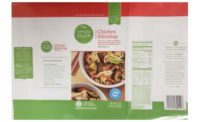Source: The Packer
As part of a broad Trump administration review of regulations on the books, the Food and Drug has taken public comments on a “Review of Existing Center for Food Safety and Applied Nutrition Regulatory and Information Collection Requirements.”
About 70 comments were received, and a couple of comments were provided by a coalition of industry associations.
Here is a comment on FDA's regulatory policy regarding Listeria monocytogenes.
On behalf of our members, the Produce Marketing Association (PMA) and United Fresh Produce Association, together with the California Fresh Fruit Association, Canadian Produce Marketing Association, Florida Fruit and Vegetable Growers Association, Northwest Horticultural Council, Texas International Produce Association, and Western Growers, respectfully submit the following comments to the Federal Register Notice of 8 September 2017 entitled “Review of Existing Center for Food Safety and Applied Nutrition Regulatory and Information Collection Requirements” [Docket No. FDA-2017-N-5094]
FDA Regulatory Policy Regarding Listeria monocytogenes Associated with Fresh Produce
Please find attached our full comments in the suggested format regarding the specific issue of “FDA Regulatory Policy Regarding Listeria monocytogenes Associated with Fresh Produce”. To summarize our comment:
The produce industry is acutely aware of the potential adverse public health consequences that can be associated with Listeria monocytogenes (Lm) and fresh produce. However, fresh produce poses a unique challenge among FDA regulated foods in that:
1) most produce items do not receive a listeriacidal treatment before consumption,
2) produce items may or may not support Lm growth,
3) preventive controls to eliminate the presence of Lm where produce is grown are very limited and
4) fresh produce is likely to have a low persistent prevalence of Lm.
The produce industry acknowledges that control of Lm must be assessed and addressed during development and implementation of preventive controls for fresh produce during postharvest handling and fresh-cut processing. However, naturally occurring transient Lm may at low prevalence and numbers occur on fresh produce in open fields where produce is grown and should not be considered an adulterant of fresh RTE produce. Therefore, it is requested that FDA consider exempting or establishing a tolerance for Lm as it relates to fresh produce RACs as there are no known preventive controls that can be implemented to reduce, control or eliminate Lm on fresh produce during growing operations in open fields. These naturally occurring levels of Lm do not ordinarily render the food injurious to health.
We thank the agency for taking on this initiative and for the opportunity to provide feedback on our priorities.
Tom Karst, The Packer's National Editor (herein referred to as TK): For more background on this issue, check out this Western Growers article Listeria: Zero Tolerance or Low Levels? from Western Growers magazine.
Another joint submission here, on the topic of the produce safety rule for agricultural water.
On behalf of our members, the Produce Marketing Association (PMA) and United Fresh Produce Association, together with the California Fresh Fruit Association, Canadian Produce Marketing Association, Florida Fruit and Vegetable Growers Association, Georgia Fruit and Vegetable Growers Association, Northwest Horticultural Council, and Texas International Produce Association, respectfully submit the attached comments to the Federal Register Notice of 8 September 2017 entitled “Review of Existing Center for Food Safety and Applied Nutrition Regulatory and Information Collection Requirements” [Docket No. FDA-2017-N-5094]
FSMA Produce Safety Rule Agricultural Water
Please find attached our full comments in the suggested format regarding the specific issue of “Produce Industry FSMA Implementing Regulation Coverage”.
Subpart E of the Produce Safety Rule focuses on agricultural water. This subpart contains testing frequencies (depending on the source), microbiological limits (depending on the use of the water) and specifies test methodology as well as other details. Interpretation of how to define and monitor that water is adequate for its intended use is situation specific based on commodity, region, and other factors. As written, 21 CFR 112 Subpart E contains prescriptive requirements that are not achievable by some growers, and further, have no quantifiable public health benefit.
Research shows that what is adequate for one region or commodity may be different in another region or commodity. A one-size-fits-all approach to water quality management is not risk-based and not adaptable based on future research. Different commodity groups and different sectors of the industry have already evaluated and implemented risk-based approaches to manage water quality in ways that are reflective of the different risks. FDA should recognize these efforts. Subpart E of the rule lacks the flexibility to incorporate new science and prevents growers from managing water quality based on their specific circumstances.
We applaud FDA’s attempt to provide flexibility through the use of “alternatives”. However, the inability to accurately assess the level of public health protection related to Subpart E precludes growers from using “alternatives” that comply with the criteria established in the rule. The recent draft guidance describing how to determine if an approach reaches the “same level of public health protection” is inadequate to give growers confidence in using alternatives.
In recognition of the concerns pertaining to Subpart E, FDA has expressed their willingness to evaluate ways to simplify the agricultural water requirements for growers. We encourage FDA to provide a timeline and process associated with this undertaking so that the industry can be prepared to comply.
We thank the agency for taking on this initiative and for the opportunity to provide feedback on our priorities.
TK: These are long-term issues for the industry, so don’t expect a quick turnaround from regulators on either of these issues. Did the associations strike the right notes in these comments? Does anyone disagree about the value of a tolerance for Lm on raw agricultural commodities or more flexibility in the water rule?
More on ag water from Food Safety Magazine:
Fixing FSMA's Ag Water Requirements
A New Era of Food Safety Regulation Begins
A Long Row to Hoe for Safer Food




